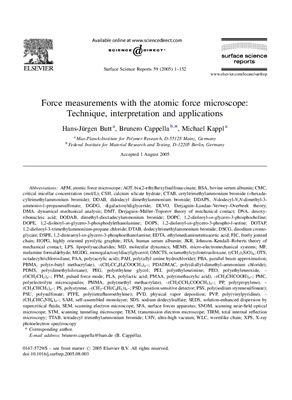Surface Science Reports 59 (2005) p.1–152
The atomic force microscope (AFM) is not only a tool to image the topography of solid surfaces at high resolution. It can also be used to measure force-versus-distance curves. Such curves, briefly called force curves, provide valuable information on local material properties such as elasticity, hardness, Hamaker constant, adhesion and surface charge densities. For this reason the measurement of force curves has become essential in different fields of research such as surface science, materials engineering, and biology. Another application is the analysis of surface forces per se. Some of the most fundamental questions in colloid and surface science can be addressed directly with the AFM: What are the interactions between particles in a liquid?
How can a dispersion be stabilized? How do surfaces in general and particles in particular adhere to each other? Particles and surfaces interactions have major implications for friction and lubrication. Force measurements on single molecules involving the rupture of single chemical bonds and the stretching of polymer chains have almost become routine. The structure and properties of confined liquids can be addressed since force measurements provide information on the energy of a confined liquid film.
After the review of Cappella [B. Cappella, G. Dietler, Surf. Sci. Rep. 34 (1999) 1–104] 6 years of intense development have occurred. In 1999, the AFM was used only by experts to do force measurements. Now, force curves are used by many AFM researchers to characterize materials and single molecules. The technique and our understanding of surface forces has reached a new level of maturity. In this review we describe the technique of AFM force measurements. Important experimental issues such as the determination of the spring constant and of the tip radius are discussed. Current state of the art in analyzing force curves obtained under different conditions is
presented. Possibilities, perspectives but also open questions and limitations are discussed.
The atomic force microscope (AFM) is not only a tool to image the topography of solid surfaces at high resolution. It can also be used to measure force-versus-distance curves. Such curves, briefly called force curves, provide valuable information on local material properties such as elasticity, hardness, Hamaker constant, adhesion and surface charge densities. For this reason the measurement of force curves has become essential in different fields of research such as surface science, materials engineering, and biology. Another application is the analysis of surface forces per se. Some of the most fundamental questions in colloid and surface science can be addressed directly with the AFM: What are the interactions between particles in a liquid?
How can a dispersion be stabilized? How do surfaces in general and particles in particular adhere to each other? Particles and surfaces interactions have major implications for friction and lubrication. Force measurements on single molecules involving the rupture of single chemical bonds and the stretching of polymer chains have almost become routine. The structure and properties of confined liquids can be addressed since force measurements provide information on the energy of a confined liquid film.
After the review of Cappella [B. Cappella, G. Dietler, Surf. Sci. Rep. 34 (1999) 1–104] 6 years of intense development have occurred. In 1999, the AFM was used only by experts to do force measurements. Now, force curves are used by many AFM researchers to characterize materials and single molecules. The technique and our understanding of surface forces has reached a new level of maturity. In this review we describe the technique of AFM force measurements. Important experimental issues such as the determination of the spring constant and of the tip radius are discussed. Current state of the art in analyzing force curves obtained under different conditions is
presented. Possibilities, perspectives but also open questions and limitations are discussed.

